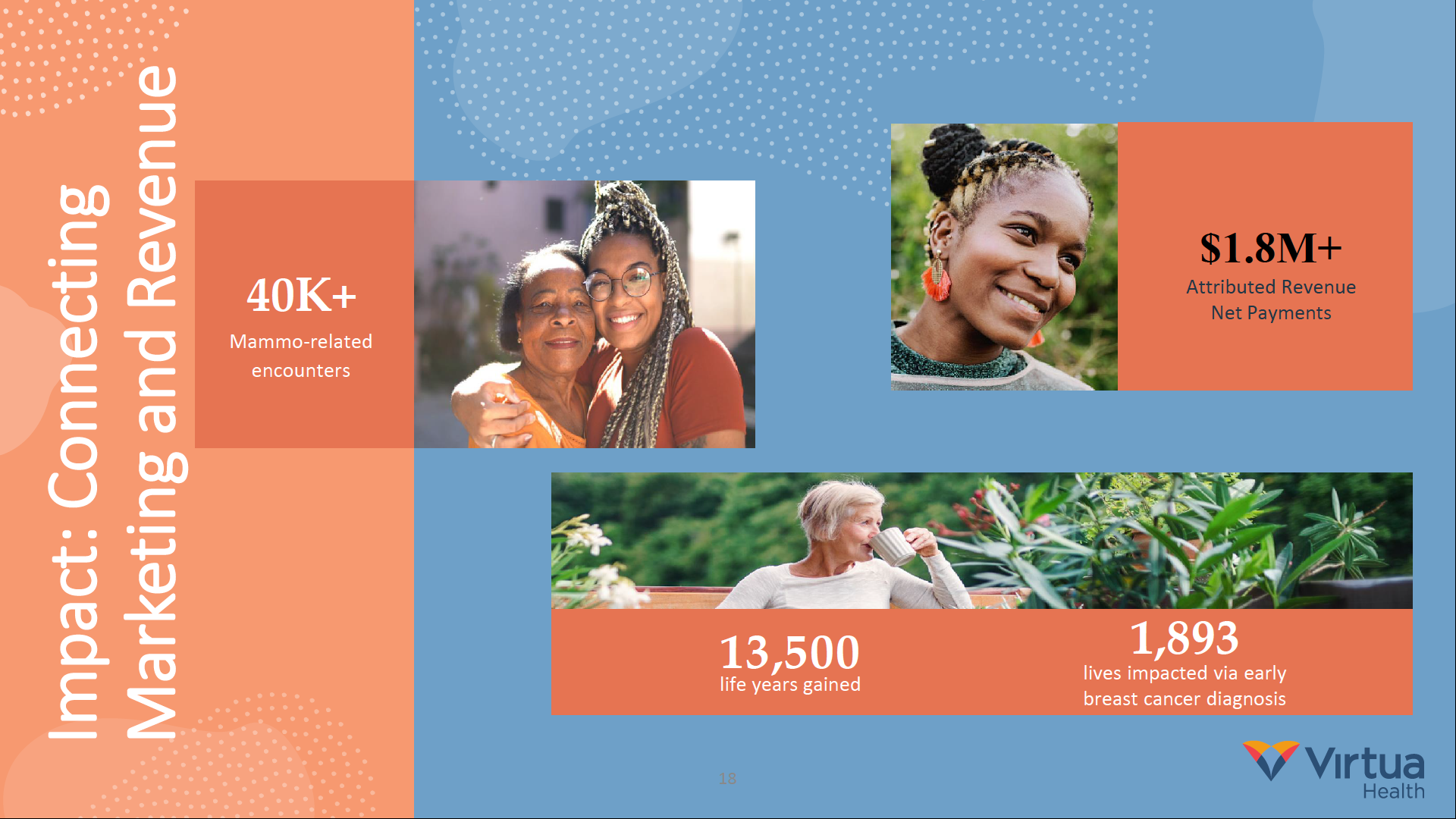The Power of Personalized Patient Retention Marketing
How Virtua Health tracked marketing efforts to revenue dollars and patient outcomes.
// By Wendy Margolin //

Imagine tracking the direct patient journey from receiving a piece of marketing content to undergoing life-saving surgery. You could measure the direct correlation of your hospital marketing communication team’s effort to improve patient outcomes. It’s every healthcare marketer’s dream — to save lives while also proving your department’s worth.
That’s precisely what Virtua Health’s marketing team managed to do using customer relationship management (CRM) software and predictive AI to inform the health system’s marketing campaigns.
What they accomplished seems like marketing magic.
Here’s just one patient-specific example from the southern New Jersey academic health system:
Meet Angela. She’s an actual patient, although that’s not her real name. She was a 52-year-old primary care patient at Virtua Health when a predictive AI model identified her to be in the highest percentile of risk for breast cancer. The marketing team sent her an initial email outreach message about breast health with a downloadable guide, as well as a resend email. She did not open either message.
Five months later, they sent another outreach email, tweaking the messaging to ask if she’d been putting off her mammogram. This time, Angela opened it. The following week, she had an appointment with her primary care physician, received an order for a mammogram, and two weeks later, had a consult with a Virtua breast surgeon and additional testing. Her breast cancer diagnosis was confirmed. Two months after opening a marketing breast health email, Angela underwent breast cancer surgery.
That email campaign was the trigger that connected Angela to the right services and clinicians she needed, with the ultimate outcome of a treatment plan that saved her life.
Read on to learn how Virtua Health achieved the goal of reaching patients with the right message at the right time, growing service line revenue, and more importantly, adding years to patients’ lives.

Bridget Reuter, manager of service line marketing at Virtua Health
Bridget Reuter, manager of service line marketing at Virtua Health, says, “The power of incorporating AI and propensity modeling into our outreach enables us to deliver the right message to the right person at the right time.”
Tying CRM Data Directly to Revenue
For Reuter and her colleague Karin Krueger, AVP of service line marketing, the ability to track breast cancer email nurture campaigns through to patient treatment is the result of a concerted patient retention marketing strategy. With the support of its AI data partner, Actium Health, the health system’s marketing team can track how marketing messages directly drive appointments.
The results are stunning. Virtua Health’s marketing team can attribute more than 40,000 mammogram-related patient encounters to their breast health campaign alone. That adds up to $1.8 million in revenue. “You can take that to your CEO when asking for a budget increase as proof of marketing ROI,” says Reuter.

The success of the campaigns extends beyond revenue. The hospital saw 1,893 breast cancer diagnoses as a direct result of the marketing outreach. The screenings potentially extended breast cancer patients’ life expectancy through detection and treatment at an earlier stage, adding up to over 13,000 years of life gained. “That is a result that we cannot put value on,” says Reuter.
A Conscious Shift to Retention
Like most healthcare marketing teams, the Virtua Health team historically emphasized patient acquisition campaigns over patient retention marketing. While seeing general success from those marketing efforts, such as building awareness and increasing engagement, they couldn’t directly track appointment conversions and revenue earned.
For example, the team honed a 40th birthday search and social media ad campaign reminding people to schedule a mammogram. It remains a top-performing campaign with high engagement.
But they wondered if they could drive even better results by using existing patient CRM data together with predictive data science to reach more people at risk for developing breast cancer. Instead of targeting all women over 40 as new acquisitions, they could layer the health system’s current patient data over predictive AI to target high-risk current patients with more specific and timely messaging.

Karin Krueger, AVP of service line marketing at Virtua Health
This shift to focus on patient retention has been key to helping the health system stay top of mind for existing patients, says Krueger. “Health systems in the same markets are all trying to engage with the same consumers, so we need to think about how we can continue to engage with our patients, keep them loyal to our brand and stay top of mind for them. You have to determine the particular balance in your marketing strategy as part of that patient experience.”
The Time Was Ripe for Change
In 2020, the breast health campaign became the team’s first attempt to use predictive modeling to deliver personalized health education content to at-risk patients. The propensity model allowed them to hone in on the audience that is most likely to need breast cancer services within the next 12 months. They tested, learned, and evolved the approach over the years until they found the right creative for two audience segments: women 39 to 49 and women 50 to 74. Working within HIPAA guidelines, they use only de-identified patient data, and the creative uses broader messaging that does not indicate any knowledge of potential for a condition.
How the CRM + Predictive Data Science Works
To better understand their customers and deliver targeted marketing messages, Virtua Health turned to its marketing data partner, Actium. Virtua wanted to use more than simply lifestyle data and instead plug into the power of its patient database to predict the likelihood that patients would need specific services. Actium was able to segment lists of patients into groups most likely to need services. They uploaded those lists to their email service provider, Marketo, to send out patient-specific marketing campaigns.
Here’s an overview of how Actium developed a CRM intelligence platform for Virtua Health:
Step 1: Actium trained its platform’s predictive model using various datasets from Virtua Health’s database of over 3.5 million patients and over eight million encounters, using EMR, population health, and claims data.
Step 2: The model analyzed the data to highlight various correlations. This allowed the health system’s marketing team to identify patients’ needs and risks.
Step 3: The model was able to assign a “next best action” for each patient. They trained the model to identify the most important action based on patients’ risks. They did this at an individual level as well as a macro level. This helped the team determine who to reach out to first.
Step 4: The Virtua team then designed and delivered the right message at the right time through a personalized email journey.
Building on Success with Additional Layers of Marketing
Once the Virtua Health team started seeing a direct increase in patient appointments, they looked for other tactics to enhance the campaign. They focused on helping patients self-identify risks with a health risk assessment tool. This supports retention and acquisition, driving an increase in mammogram appointment volume. It also drives patients to the health system’s cancer genetics testing, OB/GYN and primary care departments.
The Virtua marketing team also partnered with internal IT, MyChart and digital transformation teams to improve MyChart outreach messaging. Using MyChart, they reach out to patients who are behind on screenings by sending personalized health maintenance topics. “We can remind people who are overdue on getting a mammogram, but we also are able to place that referral order in their health records to create a better patient experience,” says Krueger.
The result of this initiative enabled Virtua Health to close the care gap by 300%. They retained patients in a region where there are many other local health partner choices while ensuring marketing and IT messaging is consistent, timely, and on brand.
The success of the breast health campaign is a model that the health system’s marketing team can copy and paste for other service lines. The revenue raised, and life-saving potential are massive.
3 key takeaways Virtua Health learned from their CRM campaign:
- Use data to engage existing consumers. Traditional marketing uses multiple touchpoints to drive conversions. Adding personalized CRM data and predictive data science to determine who to reach, what to send, and when to reach out makes traditional marketing significantly more powerful.
- The power of the nudge. Reach out to patients who don’t open emails the first time. Adjust the subject and then nudge that audience again.
- Build on your success. The Virtua Health team allows patients to opt in to receive a women’s health nurture series. This helps patients continue the conversation beyond mammogram messaging. They can build that patient relationship and personalize monthly health and wellness messaging with cross-marketing messages.
Wendy Margolin is a healthcare writer and owner of Sparkr Marketing, helping busy healthcare marketing communications teams create more content. She’s on a mission to build a better medical web, one article at a time. Her favorite form of content is hospital brand journalism, which ties together her 20-year career in journalism, marketing, and healthcare.

